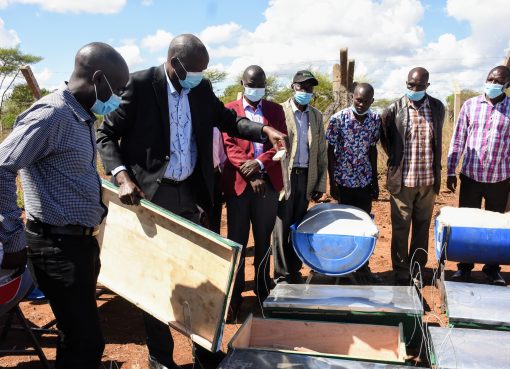The Coast Development Authority (CDA) is scaling up its development programmes for the improved socio-economic well-being of the people in the region.
The Regional Authority is also aligning its socio-economic activities in the Coast region to the Bottom-Up Economic Transformation Agenda (BETA) plan, championed by the National government, to be in tandem with the government agenda on food security.
CDA Managing Director (MD), Dr. Mohamed Keinan, says the Authority is investing in economic programmes, as well as boosting transformational agricultural, water and maritime activities in the coastal counties of Kwale, Kilifi, Lamu, Taita Taveta, and Tana River.
Dr. Keinan says development projects in the coastal counties are being aligned to the government’s five-point BETA plan, which is President William Ruto’s focal point in ensuring his Administration delivers the pledge to Kenyans.
The BETA Plan focuses on Agricultural Transformation and Inclusive Growth; Micro, Small, and Medium Enterprises (MSMEs); Housing and Settlement, Healthcare, Digital Superhighway, and the Creative Industry.
He says CDA is also rehabilitating areas surrounding the Sh20 billion Mwache Multipurpose Dam project, which seeks to help tackle persistent water shortages in Kwale, Mombasa and Kilifi.
Mwache Dam is an 87.5-meter-tall concrete gravity dyke, impounding 118 million cubic meters of water for supply and irrigation and is expected to boost the water supply for Kwale, and Mombasa counties.
The CDA has constructed gabions and installed markers and stakes around the banks of the dam site, to prevent local farmers from farming on the riparian land.
Dr. Keinan says the Mwache Dam project is part of the Second Phase of the Water Security and Climate Resilience programme, which focuses on the coastal counties of Mombasa and Kwale.
Construction of the Mwache Dam project, is meant to harness the floodwaters from Mwache River Basin in Kinango Sub-County and help tackle persistent water shortages in the coastal region.
The CDA MD says the Authority is actively engaging stakeholders in raising awareness on the importance of riparian conservation, to promote social and economic development in the region.
He says Mwache Dam, when fully operational will ensure continued contribution to food security and economic growth, prosperity, and poverty alleviation in the region.
“CDA is committed to improving the social and economic well-being of residents in the coastal region through strategic initiatives and collaborative partnerships and our focus is on fostering sustainable development, creating opportunities, and enhancing the quality of life for all,” he said during an interview.
Dr. Keinan says CDA is currently involved in projects such as the Lake Challa Smallholder Irrigation Scheme in Taita Taveta County, Chakama Smallholder Irrigation Project in Kilifi County and several drought mitigation projects.
The Sh3.3 billion Lake Challa project seeks to increase food security through the supply of water for irrigation farming, livestock production and domestic use, thereby, building the community’s resilience to climate change and improving their living standards.
Dr Keinan says the Lake Challa project, is aimed at utilizing the Lake Challa water resource to supply water for domestic and irrigation use for the benefit of the residents and supply water to support livestock, fisheries, and forestry including wildlife.
He noted the Lake Challa Irrigation Scheme will ensure the prosperity of the people of Taita Taveta and fulfill the vision of the government in terms of the BETA development agenda.
The MD says CDA is scaling Climate- and Nutrition-Smart Crops in the coastal region, by enhancing the climate, nutrition, and economic resilience of smallholder farming households.
Dr. Keinan says climate volatility is leading to decreased crop yields, food insecurity, and malnutrition, hence the need for CDA to support climate-resilient and sustainable agriculture.
“CDA has prioritized food security programs to help combat poverty among local communities striving to create a sustainable and inclusive environment, where everyone has equal opportunities to thrive,” says Dr. Keinan.
Director Planning and Research at CDA, Dr. Geoffrey Rono says the Authority is now shifting its focus on livestock feedlots, to boost beef production, the fruit-tree program and the blue economy sector.
Dr. Rono says the blue economy sector encompasses fisheries, maritime biotechnology, aquaculture, tourism and marine transport and logistics and was the ‘next frontier of development for the coastal counties’.
Dr. Rono noted the country’s Exclusive Economic Zone (EEZ) of 200 nautical miles into the Indian Ocean, with immense marine resources had not been fully explored and utilized.
He says CDA will promote sustainable investments in the blue resources and unlock the potential of the ocean frontier to contribute to economic growth.
“CDA is alive to the fact that the Indian Ocean presents an abundance of untapped opportunities for sustainable socio-economic growth,” he said, stating that the vision behind CDA projects is centered on the distinct needs of the communities.
He says CDA will seek the sustainable exploitation of resources in the potentially lucrative maritime sector of the country’s maritime Exclusive Economic Zone (EEZ) of about 200 nautical miles.
On the feedlots, Dr. Rono says CDA is seeking to establish livestock feedlots in the coastal counties, noting that the feedlot project will boost food security, a major pillar in the BETA development agenda, through an increase in supply of livestock for the local and export markets.
He says by introducing livestock feedlot, CDA is adopting Climate Smart Agriculture in Livestock Farming in Arid and Semi-Arid lands.
Dr. Rono says the feedlots will be special holding zones for animals, where they are treated, fed with various protein rations, to boost weight gain, and then released to the market for sale.
“The adoption of feedlot farming represents an intensive production system to grow and or fatten cattle until they reach slaughter weight for the export market,” he said, adding that the feedlots would unlock the economic potential of the arid regions.
By Hussein Abdullahi





